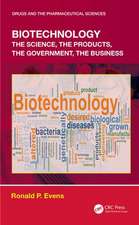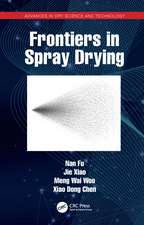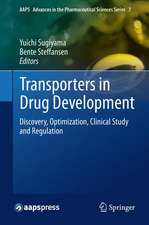Global Approach in Safety Testing: ICH Guidelines Explained: AAPS Advances in the Pharmaceutical Sciences Series, cartea 5
Editat de Jan Willem van der Laan, Joseph J. DeGeorgeen Limba Engleză Hardback – 8 feb 2013
| Toate formatele și edițiile | Preț | Express |
|---|---|---|
| Paperback (1) | 945.92 lei 6-8 săpt. | |
| Springer – 6 mar 2015 | 945.92 lei 6-8 săpt. | |
| Hardback (1) | 950.96 lei 6-8 săpt. | |
| Springer – 8 feb 2013 | 950.96 lei 6-8 săpt. |
Din seria AAPS Advances in the Pharmaceutical Sciences Series
- 5%
 Preț: 1054.33 lei
Preț: 1054.33 lei - 5%
 Preț: 1487.04 lei
Preț: 1487.04 lei - 18%
 Preț: 1132.98 lei
Preț: 1132.98 lei - 18%
 Preț: 952.86 lei
Preț: 952.86 lei - 18%
 Preț: 960.42 lei
Preț: 960.42 lei - 18%
 Preț: 1342.08 lei
Preț: 1342.08 lei - 18%
 Preț: 1563.24 lei
Preț: 1563.24 lei - 18%
 Preț: 1233.69 lei
Preț: 1233.69 lei - 18%
 Preț: 952.57 lei
Preț: 952.57 lei - 15%
 Preț: 639.37 lei
Preț: 639.37 lei - 5%
 Preț: 1630.22 lei
Preț: 1630.22 lei - 24%
 Preț: 791.47 lei
Preț: 791.47 lei - 5%
 Preț: 1426.71 lei
Preț: 1426.71 lei - 15%
 Preț: 646.25 lei
Preț: 646.25 lei - 18%
 Preț: 947.35 lei
Preț: 947.35 lei - 18%
 Preț: 1560.73 lei
Preț: 1560.73 lei - 18%
 Preț: 1573.36 lei
Preț: 1573.36 lei - 18%
 Preț: 1395.47 lei
Preț: 1395.47 lei - 18%
 Preț: 1002.61 lei
Preț: 1002.61 lei - 18%
 Preț: 1388.99 lei
Preț: 1388.99 lei - 18%
 Preț: 1012.84 lei
Preț: 1012.84 lei - 18%
 Preț: 1235.43 lei
Preț: 1235.43 lei - 18%
 Preț: 1002.94 lei
Preț: 1002.94 lei - 18%
 Preț: 952.72 lei
Preț: 952.72 lei - 18%
 Preț: 1135.02 lei
Preț: 1135.02 lei - 18%
 Preț: 1409.21 lei
Preț: 1409.21 lei - 18%
 Preț: 995.17 lei
Preț: 995.17 lei - 18%
 Preț: 1019.35 lei
Preț: 1019.35 lei - 18%
 Preț: 1837.26 lei
Preț: 1837.26 lei - 15%
 Preț: 660.83 lei
Preț: 660.83 lei
Preț: 950.96 lei
Preț vechi: 1159.71 lei
-18% Nou
Puncte Express: 1426
Preț estimativ în valută:
181.96€ • 189.98$ • 150.60£
181.96€ • 189.98$ • 150.60£
Carte tipărită la comandă
Livrare economică 04-18 aprilie
Preluare comenzi: 021 569.72.76
Specificații
ISBN-13: 9781461459491
ISBN-10: 1461459494
Pagini: 328
Ilustrații: XII, 315 p. 16 illus., 13 illus. in color.
Dimensiuni: 155 x 235 x 22 mm
Greutate: 0.6 kg
Ediția:2013
Editura: Springer
Colecția Springer
Seria AAPS Advances in the Pharmaceutical Sciences Series
Locul publicării:New York, NY, United States
ISBN-10: 1461459494
Pagini: 328
Ilustrații: XII, 315 p. 16 illus., 13 illus. in color.
Dimensiuni: 155 x 235 x 22 mm
Greutate: 0.6 kg
Ediția:2013
Editura: Springer
Colecția Springer
Seria AAPS Advances in the Pharmaceutical Sciences Series
Locul publicării:New York, NY, United States
Public țintă
ResearchCuprins
The International Conference on Harmonisation. History of Safety Guidelines.- EU Perspective on ICH.- The Value and Benefits of the International Conference on Harmonisation (ICH) to Drug Regulatory Authorities Advancing Harmonization for Better Public Health.- A Japanese Perspective on Implementation of the Three Rs: Incorporating Best Scientific Practices into Regulatory Process.- Towards more Scientific Relevance in Carcinogenicity Testing.- The Evolution, Scientific Reasoning and Use of ICH S2 Guidelines for Genotoxicity Testing of Pharmaceuticals.- Toxicokinetics: A Guidance for Assessing Systemic Exposure in Toxicology Studies , Where are we now; an S3A/S3B update (1995-2011).- Duration of Acute and Chronic Toxicity Testing in Animals (ICH S4A and S4B).- Why and how did Reproduction Toxicity Testing make its early entry into and Rapid Success in ICH?.- ICH S6 Preclinical Safety Evaluation of Biotechnology-Derived Pharmaceuticals.- Safety Pharmacology: Guidelines S7A and S7B.- ICH S8: History and Perspectives.- ICH S9: Nonclinical Evaluation of Anticancer Pharmaceuticals a Perspective from Regulators on the Development of the Guideline.- Non-Clinical Safety Studies for the Conduct of Human Clinical Trials for Pharmaceuticals ICH M3 and M3(R2).
Recenzii
From the reviews:
“This book is an excellent read and gives detail into all aspects of nonclinical testing needed to get new drugs into the clinic and beyond, as well as useful insight into the decisions behind the testing recommendations in the guidelines. Well done editors in putting all this together.” (Paul Baldrick, BTS Newsletter – The British Toxicology Society, Issue 43, Winter, 2013)
“This book is an excellent read and gives detail into all aspects of nonclinical testing needed to get new drugs into the clinic and beyond, as well as useful insight into the decisions behind the testing recommendations in the guidelines. Well done editors in putting all this together.” (Paul Baldrick, BTS Newsletter – The British Toxicology Society, Issue 43, Winter, 2013)
Notă biografică
Dr. Jan Willem van der Laan was from 1990-2007 heading the Section Pharmacology and Toxicology Assessment at the National Institute for Public Health and the Environment (RIVM, Bilthoven). In this function he was responsible for the advice on non-clinical safety aspects for the Netherlands ‘College’, the Medicines Evaluation Board. Since September 2007 he is still senior assessor in pharmacology and toxicology. He was from 2002-2010 project leader of the Teratology Information Service at the Institute. He moved in 2012 to the Medicines Evaluation Board located in Utrecht, but his role as senior assessor has not been changed. On behalf of this Board he is a member and vice-chair of the Safety Working Party (SWP) of the CHMP. His contributions to the International Conference on Harmonization started in early 1992 when he became a member of the Expert Working Group on Carcinogenicity Testing. Later on he became EU rapporteur for another topic in the Safety area, i.e. Immunotoxicology. In 2011 he finished as the EU rapporteur the Addendum for the Preclinical testing of Biotechnology-derived Proteins (ICH S6). In 2012 he is again involved in the new start of a topic on Carcinogenicity.
Joseph J. DeGeorge has a Ph.D. in Pharmacology from SUNY, Upstate Medical Center, Syracuse, NY, was a Postdoctoral Fellow at UNC, Chapel Hill, NC, and Burroughs-Wellcome Research Institute, and was a Senior Staff Fellow at the NIH/NIA in the Laboratory of Neuroscience. He has been actively engaged in the Safety and Multidisciplinary topics of the ICH as an Expert, Topic Rapporteur, and Safety Lead on numerous topics since the early 1990s. He is still actively engaged in ICH as of 2012. He has served these roles originally as a Food and Drug Administration representative and, following a brief hiatus, returned to the ICH as a PhRMA representative. He began his participation in the ICH process while serving as a Pharmacology and Toxicology reviewer inthe Neuropharmacology Division, CDER, FDA and took on increasing responsibility as his career progressed, culminating in the role of FDA ICH Safety Lead and Associate Director for Pharmacology and Toxicology for the Office of New Drugs, CDER/FDA. He joined the pharmaceutical industry in 2002, and has been Vice President of Global Safety Assessment at Merck &Co. since 2004. He also serves as the PhRMA Lead for ICH Safety topics, participating in the development of numerous new and revised ICH Safety Guidance's with a goal of enabling the safe and efficient development of new medicinal products.
Joseph J. DeGeorge has a Ph.D. in Pharmacology from SUNY, Upstate Medical Center, Syracuse, NY, was a Postdoctoral Fellow at UNC, Chapel Hill, NC, and Burroughs-Wellcome Research Institute, and was a Senior Staff Fellow at the NIH/NIA in the Laboratory of Neuroscience. He has been actively engaged in the Safety and Multidisciplinary topics of the ICH as an Expert, Topic Rapporteur, and Safety Lead on numerous topics since the early 1990s. He is still actively engaged in ICH as of 2012. He has served these roles originally as a Food and Drug Administration representative and, following a brief hiatus, returned to the ICH as a PhRMA representative. He began his participation in the ICH process while serving as a Pharmacology and Toxicology reviewer inthe Neuropharmacology Division, CDER, FDA and took on increasing responsibility as his career progressed, culminating in the role of FDA ICH Safety Lead and Associate Director for Pharmacology and Toxicology for the Office of New Drugs, CDER/FDA. He joined the pharmaceutical industry in 2002, and has been Vice President of Global Safety Assessment at Merck &Co. since 2004. He also serves as the PhRMA Lead for ICH Safety topics, participating in the development of numerous new and revised ICH Safety Guidance's with a goal of enabling the safe and efficient development of new medicinal products.
Textul de pe ultima copertă
The International Conference on Harmonisation of Technical Requirements for Registration of Pharmaceuticals for Human Use (ICH) is a unique project that brings together the regulatory authorities of Europe, Japan and the US and experts from the pharmaceutical industry in the three regions to discuss scientific and technical aspects of product registration. In Japan, the members are the Ministry of Health, Labour and Welfare (MHLW), and the Japan Pharmaceutical Manufacturers Association (JPMA). In Europe, the members are the EU (Representatives of the European Commission and the European Medicines Agency [EMA]), and the European Federation of Pharmaceutical Industries and Associations (EFPIA). In the United States, the members are the Food and Drug Administration (FDA), and the Pharmaceutical Research and Manufacturers of America (PhRMA). The International Federation of Pharmaceutical Manufacturers Associations (IFPMA) is the secretariat of the ICH. Additional members include Observers from WHO, European Free Trade Association (EFTA), and Canada. The Observers represent non-ICH countries and regions.
This volume considers one of ICH’s major categories, Safety, covering topics relating to in vitro and in vivo pre-clinical studies (Carcinogenicity Testing, Genotoxicity Testing, etc.). Since the start of the ICH process, many guidelines have been written, but in most cases there is a lack of awareness of the many issues that were addressed during the development of the consensus guidances. Further, just as it is important to understand what the guidances state, it is also important to understand the thoughts, debates, and intent of the experts involved, which are not included in the guidance documents. Why has the guideline been written as it is written, why are some topics ignored, and why have some initial guidance proposals have been deleted. These and other related questions and answersare the contents of this book, written by experts who were directly involved in writing the ICH guidances that drive drug development today.
This volume considers one of ICH’s major categories, Safety, covering topics relating to in vitro and in vivo pre-clinical studies (Carcinogenicity Testing, Genotoxicity Testing, etc.). Since the start of the ICH process, many guidelines have been written, but in most cases there is a lack of awareness of the many issues that were addressed during the development of the consensus guidances. Further, just as it is important to understand what the guidances state, it is also important to understand the thoughts, debates, and intent of the experts involved, which are not included in the guidance documents. Why has the guideline been written as it is written, why are some topics ignored, and why have some initial guidance proposals have been deleted. These and other related questions and answersare the contents of this book, written by experts who were directly involved in writing the ICH guidances that drive drug development today.
Caracteristici
Written by experts who were involved in the ICH process Provides state-of-the-art guidance Guidelines serve as teaching tools


















